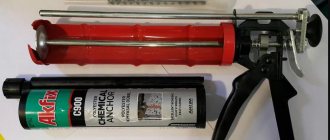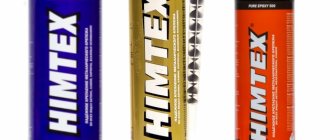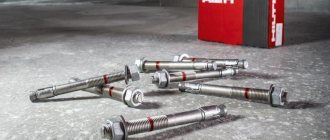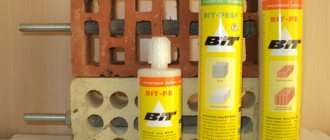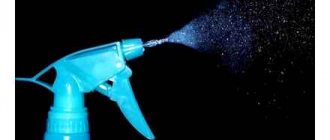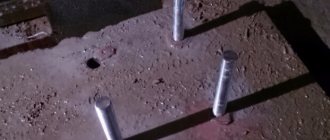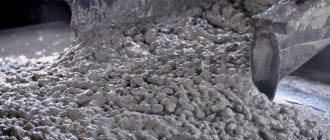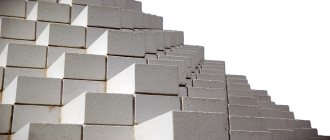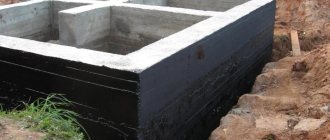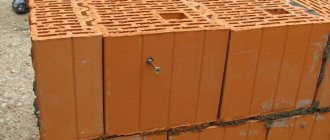A chemical anchor for concrete is a special, quick-hardening, semi-liquid mass that is glued into the mounting hole and becomes the basis for fastening bolts, metal threaded rods, metal rods, pins, etc. The fastening element is also called a liquid or injection anchor, or a chemical dowel.
Typically, a two-component synthetic resin is used as the basis of the composition, which ensures the connection and reliable fixation of metal materials in the monolith. This type of dowel is relatively new, but is already actively used in repair and construction work, allowing bolts and nails to be firmly secured in hollow, porous materials.
They are usually used where it is not possible to attach plastic or metal dowels - in hollow concrete structures, hollow ceramics, brick, expanded clay concrete, limestone, shell rock, sandstone. Chemical anchors for concrete are also relevant when working with dense concrete bases.
The composition of the chemical anchor: synthetic acrylate, polyester, polyurethane or epoxy resin for gluing, filler (sand, cement) and hardener to form a strong fastening base and make it possible to use the fastener after 1-10 hours.
What is a chemical anchor?
Chemical anchor (liquid anchor, liquid dowel, adhesive anchor) is a two-component adhesive composition based on synthetic resins, which is a high-tech adhesive system. Externally, it is a tube of glue, in addition to which you need to purchase a special gun for a chemical anchor.
Chemical anchor gun
Initially, the new product was used mainly in the mining industry for the installation of structures and their fastening to loose rocks. Now anchors are successfully used in all areas of construction.
Important! The main difference between liquid anchors and traditional spacer elements is that chemicals provide a higher degree of fixation on fragile, unstable, and complex-structured materials.
Reliability of fastening is achieved through the inclusion of special components in the anchors - synthetic resins based on polyurethane, acrylic, polyester, epoxy oligomers. The exact proportions and names of the components are a trade secret of each manufacturer.
Approximate composition of chemical anchors, in addition to resins:
- fine-grained quartz sand;
- cement;
- hardener, etc.
What are aerated concrete anchors?
For the construction of low-rise buildings, aerated concrete, or rather foam block, is increasingly being used. The material is light and porous and needs protection from external factors. For finishing houses made of aerated concrete, a hinged ventilated facade is used, the basis of which is load-bearing profiles. Anchors are used to attach the profile to the foam block.
An anchor is a cylindrical fastening element consisting of a spacer part and an internal rod.
- Spacer part – fixes the anchor body in the porous structure of aerated concrete. The fastening method can be mechanical or chemical;
- Rod – connects the spacer part and the profile.
The diameter of the fastening element is 8-30 mm. The length depends on the type of base, the weight of the suspension system and the thickness of the wall. Usually 40-300 mm.
Operating principle
Liquid anchor is quite easy to use. First, a hole is made in a concrete, brick or other surface, into which the adhesive mass is injected using a gun, and then a metal element is inserted - a rod, a pin, a corrugated reinforcing rod.
As a result, the chemical composition envelops the metal, filling even the smallest gaps between the turns of the thread and the pores of the base. The resins then harden, forming a dense monolith that securely holds the metal part inside the structure. The anchor connection can withstand the highest loads and in this respect is superior to conventional types of fasteners.
Dimensions and characteristics of anchor bolts
Initially, before choosing a pin, you need to know the dimensions, since fasteners come in all sizes and calibers.
Groups of anchors by size: small – in section up to 8 ml/length up to 55; middle – up to 12/120 ml; large – with the largest dimensions D=24 and L=220 ml.
Foundation pins with different dimensions, their parameters are determined by 3 characteristics.
Let's decipher the marking M8 10/60-115: D of cutting - M8, outer D = 10 (this D coincides with D of the drill with which the hole will be drilled), length of the pin - 115 ml, thickness of the part - 60 ml.
All operational parameters of the anchors are indicated in the report card, these will be mass, maximum torque and bending period, minimum pulling power, rational overloads. In accordance with the various given characteristics, the necessary models are selected and a good connection is made to the concrete structures of the pin.
Scope of application
A chemical anchor is most suitable for aerated concrete, stone, concrete, and brick (including hollow brick), although it can be used when working with a wide variety of materials.
Important! The use of anchors is especially important in situations where traditional fasteners and dowels cannot ensure a reliable connection. This applies to work with materials such as limestone, expanded clay concrete, cellular concrete, sandstone.
Dowel for aerated concrete
Areas of application of chemical anchor:
- house building – installation of roofing, balconies, building canopies, gazebos, gates;
- fixation of any steel elements;
- installation of handrails in tunnels and other work requiring electrical insulation;
- installation of ventilation systems on weak foundations;
- fastening of large-sized structures;
- arrangement of various underwater structures;
- installation of lifts at ski resorts, advertising elements, scaffolding;
- strengthening the foundation of buildings, connecting to the foundation;
- replacement of reinforcement in critical structures - bridges, stairs, ceilings, support columns, overpasses;
- installation of auxiliary equipment - plumbing, satellite dishes, lights.
Installation of metal structures
The metal fastener itself, suitable for working with a chemical anchor, can be made of stainless steel, carbon or galvanized steel. The composition can be used in conditions of any humidity, including under water.
How to install an anchor bolt in concrete
The whole process is quite simple, the main thing is to take the measurements correctly and implement everything as accurately as possible. But there are several nuances that need to be taken into account.
Practical tips for installing anchors in concrete:
- The strength of the fastener is influenced not only by the anchor, but also by the quality of the base material (concrete in this case), proper preparation for installation, taking into account the material of the attached structure and the design of the bolt itself.
- If a layer of finish is applied to the wall, the hole must be deeper because the finish is usually less durable than concrete.
- It is advisable to take a drill 0.5 millimeters thinner than the diameter of the future hole.
- When working with a hammer drill, it is best to use a tip made of a special carbide material.
- Read the instructions carefully - the packaging with anchors should indicate the permissible force and the maximum number of revolutions.
- When screwing the anchor into, under no circumstances should you twist it all the way, as the material may collapse.
Eternal fastener: concrete dowel
A dowel is a spacer element made of polypropylene or nylon, which is similar in function and performance to an anchor. It cannot be used independently; it is fixed in concrete with special nails or self-tapping screws. To strengthen the fixation, it is often performed with spikes or antennae.
This type of fastening is used where there are not too large loads on the concrete - fastening shelves, TV hooks, lighting fixtures. The dowels are driven into the dowels with a hammer, and the screws are screwed in with a screwdriver or screwdriver. You will also need a regular hammer to drive in nails.
You can also find dowel nails designed for use with a mechanical gun. The fasteners in concrete are made of metal; in appearance, they somewhat resemble a bullet. Relevant where you need to hang a large number of small items.
Concrete dowel: fast but durable
Pins are those that are most often used for arranging fasteners near the edges of a concrete wall. The fastener does not require additional fixation; it is screwed into the hole, where a little epoxy glue is first poured. There is no need to drill holes - the dowel can be screwed directly into the concrete wall. If you still need to make a hole in concrete, then it is better to choose a drill (a hammer drill can damage the wall).
They screw it in with a screwdriver - and after that it is no longer possible to unscrew the dowel back. Therefore, preliminary marking must be done especially carefully.
Types of anchors
Chemical anchors for concrete and other materials are sold in two forms: ampoules and cartridges.
Ampoule
Such anchors are produced for screws of a certain diameter. That is, each fastening point needs its own ampoule - a glass capsule with one-component content or two ampoules with an adhesive and a hardener.
The ampoule is inserted into the hole, after which a metal fastener is inserted, which breaks it. The glue flows out and sets, and the glass shards only help to strengthen the bond.
Capsule Type Chemical Anchor
Typically, ampoule anchors are used where particular precision of the joint is important. It is convenient to work with them, because there is no need to monitor the filling of the hole.
Important! This type of glue is not suitable for vertical structures made of cellular material. The composition will flow down before it hardens.
For the same reason, an ampoule chemical anchor is not suitable for bricks with holes: it is only suitable for solid building materials.
Cartridge
Cartridge anchors are also called injection or injection compounds. They are sold in the form of a volumetric cartridge with a pair of compartments that are filled with different compounds (resin and hardener).
Also on sale are products from two cartridges, the mass of which is mixed in a special gun. Most cartridge anchors are universal, but special compounds for concrete are also available.
Cartridge with two components of the composition
To perform fastening work, put a mixing spout on the cartridge, then insert it into the gun and perform all the necessary actions. This type of chemical anchor is suitable for use on hollow materials.
Before filling, a metal sleeve or plastic sleeve is inserted into the drilled hole so that the composition does not fill large voids in the base. The disadvantage of cartridge anchors is the risk of using too much.
Advice! To reduce consumption, mesh bushings are used, which are selected according to the size of the holes.
Fastener design
There are two types of anchorage depending on the location and method of applying the adhesive:
- The himanker is attached using an injection glue gun, which is loaded with two capsules of resin and hardener. Using piston pressure, their contents are squeezed out of the containers and mixed into a homogeneous mass in the nozzle of the gun using a spiral. The adhesive composition is fed into a drilled hole with an anchor rod fixed in it. The solution fills the entire volume of voids around the fasteners, including voids in brick or foam block.
- The glass capsule contains the active component of glue and hardener, separated by a partition. The mounting hole is drilled along the diameter of the capsule. The container is inserted into the prepared recess and a pin is inserted using a drill or hammer, which breaks the wall of the capsule. The adhesive and hardener are mixed to firmly secure the stud into the wall. Glass shards additionally reinforce the fastening.
Important! The capsule anchor is not used for vertical fastening in ceilings. The glue may leak and the connection will not form.
A chemical anchor consists of several parts that form a connection:
- Adhesive based on phenol-formaldehyde, polyurethane or polystyrene resin,
- The hardener accelerates the drying process of the adhesive composition,
- Fillers increase the strength and reliability of the connection, usually quartz sand or cement is used,
- A metal rod in the form of a bolt, pin, nail or piece of reinforcement.
Pros and cons of chemical anchors
The building composition has many positive characteristics:
- absolute tightness of the attachment point;
- absence of tensile loads, which is especially important for concrete foundations;
- versatility, ability to operate in various areas of construction and repair, suitability for any materials;
- ease of use, no need for special knowledge and skills;
- the highest strength after final hardening - an indicator greater than that of conventional metal anchors and dowels with a sleeve;
- significant load-bearing capacity, tolerance of serious mechanical loads, regardless of the type of base material;
- resistance to chemicals, corrosion, and negative atmospheric factors;
- Possibility of use at high humidity, under water;
- long service life - up to 50 years;
- absence of toxic compounds (not in all formulations), suitability for indoor use;
- approximate equality of the coefficients of thermal expansion of the composition and most building foundations, which reduces the risk of internal stresses during temperature fluctuations.
Advantages of a chemical anchor over a conventional one
The disadvantages of chemical anchors include a rather long time until complete polymerization and readiness to absorb maximum loads. So, at a temperature of about +50 degrees this time will be 5-7 hours, and at ordinary room temperatures it will be much longer.
During the cold season, the curing process may stop altogether. The shelf life of such formulations is limited - it makes no sense to use them 12 months after production, even if the packaging was sealed.
After opening, you will have to use the product in one go, so for the sake of a couple of fastenings it is better to buy ampoule anchors. The price for this type of fastener is quite high, which repels some buyers.
Advantages and disadvantages
To understand what a chemical anchor for concrete is and where it can be useful (and where it will become the only possible method of fastening), it is necessary to study the main pros and cons of this type of connection.
Main advantages of chemical anchor:
- Maximum connection strength
- Safety and environmental friendliness (provided that non-toxic components are used in the production of the adhesive composition), no unpleasant odor
- Wide scope of use - on land and in water, inside and outside buildings, in dense materials and porous
- Does not provoke a tensile load, does not expand, does not produce expansion stress, so the chemical anchor can be used directly at the edge of the structure
- Simple, quick and easy installation – regardless of whether the chemical anchor is used in an ampoule or cartridge
- Ability to withstand severe tensile stresses
- Tightness - complete sealing of the hole where the anchor and bolt are inserted
- Service life is 50 years or more
- Resistance to negative atmospheric factors, corrosive, chemical, physical influences
- Resistance to shock and vibration loads
- Wide range of temperatures at which the anchor can be used - some manufacturers offer fasteners for installation at -18 and up to +40C
- Ability to use any fastener - smooth and grooved reinforcing bars, threaded bolts, bushings, pins and other metal elements
Among the disadvantages of chemical anchors, it is worth noting their high cost, short shelf life in the package (regardless of whether it is open or closed), and the inability to use all brands in the cold. Most anchors harden in 20 minutes to 6 hours, but if the temperature drops below -5C, not every adhesive will be able to provide adequate strength. But, for example, some Hilti chemical anchors can be installed at a temperature of -23C.
Certain difficulties may arise when using cartridges that require filling the hole with a maximum of two-thirds of the composition. It is not easy for beginners to immediately learn how to determine the degree of filling of the hole, which is why the glue can come out. When using ampoules, such a disadvantage is not observed.
Selection rules
Before purchasing, it is important to carefully read the instructions for the chemical anchor. Manufacturers always indicate the types of structures and base materials to which this or that composition is suitable.
It is equally important to take into account the temperature conditions when working with the product, permissible loads on the structure, and possible humidity range. In addition, the anchor must meet the conditions of use according to the following indicators:
- types of fastening;
- fastener placement options;
- dimensions of metal rods;
- hole depth;
- curing speed;
- the need for a mesh sleeve.
For cartridge anchors, you will have to additionally buy a special dispenser gun, which is capable of mixing two components of the composition and dispensing them into a special spout. The price of such a product varies from 1300 to 7000 rubles.
Advice! Ampoule guns are cheaper - from 700 rubles, although you can use a regular drill instead.
Instructions for use
Even a beginner can use chemical anchors. The work includes drilling a hole, preparing it and filling it with compound, as well as screwing in metal bolts. Installation of fasteners is carried out at a temperature not lower than -5 degrees, or using special frost-resistant compounds.
Rules for drilling and preparing holes
When making holes for a chemical anchor and rod, you need to remember: the higher the load on the structure, the more accurate and better all work must be done. In any case, the hole diameter is made larger than the stud or reinforcement.
Drilling is carried out with a hammer drill with a drill of the required size. For cone-shaped holes, special drills with an oscillating jig are used; for drilling concrete walls, hollow drills are used.
Drill with oscillating jig
The finished hole is thoroughly cleaned of dust, preferably using air under pressure. It is best to use a carbon dioxide cylinder. If it is not available, a regular rubber bulb will do.
Important! After blowing, be sure to clean the hole with a brush and blow through again so that no dust remains inside - this is a very important condition for reliable adhesion of the composition to the base.
Sequence of work when gluing
The ampoule is installed directly into the hole of the structure, the pin is inserted using an electric drill or manually. In porous or hollow materials, a mesh sleeve is pre-fixed, which will allow the composition to be distributed more evenly.
The cartridges are placed in a gun with a guide spout, which will squeeze out the mass under pressure. If the length of the metal pin is more than 50 cm, it must be installed mechanically - using a special jig. The fasteners are left until completely hardened (the time is always indicated in the instructions).
How to prepare the material yourself
To save money, you can make your own chemical anchor based on epoxy resin. The finished composition is perfect for working with porous and dense materials.
The procedure for creating a tool is as follows:
- Combine ED-20 grade epoxy resin with DBP or DEG-1 plasticizer (up to 5-10% of the resin volume), mix well.
- Add gypsum or cement (also about 5-10%), knead until lumps disappear.
- Combine the composition with hardener UP-583 in a ratio of 1:8-1:10, mix again.
- The composition is fully developed within a minimum time.
- For polymerization, leave the chemical anchor for 12-24 hours.
Anchors for concrete: weight and dimensions
Anchor bolt sizes are determined by the material used and the intended use of the product. Each manufacturer is regulated by general and internal standards. But there are parameters that are similar for all suppliers.
So, depending on the type of anchor, as a rule, the diameter/length of the product looks like this (in mm):
- wedge: 6-20/40-421;
- spacer: 5-24;
- scoring: 6-20.
The tables provide detailed information regarding the dimensions and total weight (in kg. 1 pc.) of popular concrete anchors, compiled on the basis of products from leading manufacturers (Hilti, Fischer, etc.).
Klinova
| Size | PC. in 1 kg | Weight 1 piece, gr. | Size | PC. in 1 kg | Weight 1 piece, gr. |
| 6*40 | 100 | 10 | 10*150 | 12 | 85 |
| 6*65 | 67 | 15 | 12*100 | 11 | 94 |
| 6*95 | 50 | 20 | 12*120 | 10 | 104 |
| 8*50 | 46 | 22 | 12*135 | 8 | 133 |
| 8*75 | 30 | 34 | 12*150 | 8 | 139 |
| 8*80 | 25 | 39 | 16*105 | 6 | 179 |
| 8*105 | 25 | 41 | 16*140 | 5 | 220 |
| 10*65 | 17 | 60 | 16*180 | 4 | 275 |
| 10*80 | 15 | 71 | 16*200 | 4 | 320 |
| 10*95 | 13 | 79 | 20*160 | 3 | 383 |
| 10*120 | 14 | 74 | 20*200 | 2 | 500 |
| 10*130 | 13 | 78 | 20*300 | 2 | 738 |
Classical
| 6,5*18 | 189 | 5 | 12*130 | 13 | 83 |
| 6,5*36 | 115 | 9 | 12*150 | 10 | 110 |
| 6,5*56 | 80 | 13 | 12*180 | 8 | 130 |
| 6,5*75 | 58 | 18 | 12*200 | 7 | 147 |
| 8*40 | 75 | 14 | 12*250 | 6 | 188 |
| 8*65 | 45 | 22 | 12*300 | 5 | 219 |
| 8*85 | 37 | 28 | 14*100 | 12 | 86 |
| 8*100 | 31 | 33 | 14*120 | 12 | 88 |
| 8*120 | 27 | 38 | 14*150 | 9 | 118 |
| 10*40 | 36 | 28 | 14*200 | 7 | 163 |
| 10*60 | 32 | 32 | 14*250 | 6 | 195 |
| 10*97 | 25 | 40 | 16*110 | 7 | 160 |
| 10*125 | 17 | 61 | 16*150 | 5 | 240 |
| 10*150 | 15 | 68 | 16*180 | 5 | 250 |
| 10*180 | 12 | 87 | 16*220 | 4 | 260 |
| 10*200 | 10 | 100 | 16*250 | 4 | 290 |
| 10*250 | 7 | 150 | 20*151 | 5 | 248 |
| 12*60 | 20 | 51 | 20*200 | 3 | 405 |
| 12*75 | 17 | 61 | 20*250 | 2 | 500 |
| 12*100 | 15 | 67 | 20*300 | 2 | 568 |
Driven (steel and brass)
| Size | PC. in 1 kg | Weight 1 piece, gr. | Size | PC. in 1 kg | Weight 1 piece, gr. |
| M6 | 6 | 160 | M6 | 250 | 4 |
| M8 | 92 | 11 | M8 | 128 | 8 |
| M10 | 42 | 24 | M10 | 75 | 14 |
| M12 | 21 | 48 | M12 | 39 | 26 |
| M16 | 13 | 80 |
The chemical anchor is characterized by the size of the capsules. Their diameter can be 10-42 mm. Length indicators range from 80 to 360mm. The package includes injection formulations with a volume of 150-825 ml. 1-2 mixers and an adapter may also be present.
Manufacturers rating
Compositions from different manufacturers are available on the market. At the same time, the chemical anchors described below can boast of proven quality.
"Titanium"
The basis of the Titan EV-I composition is polyester resin. The dried mixture can work at temperatures up to +80 degrees, while complete polymerization at +25 degrees occurs in just 3 minutes. There is a winter version of Titan EV-W anchors on sale, which can be applied even at -18 degrees.
Sormat
The Finnish company Sormat produces anchors in cylinders and ampoules of various sizes, as well as disposable nozzles for their application. The adhesive is made on the basis of polyester resin and is intended for fastening medium-heavy structures.
BIT
This adhesive composition is used even at sub-zero temperatures (down to -18 degrees). Its base is epoxy acrylate resin.
Main characteristics of the material:
- capable of connecting even heavy concrete structures;
- Suitable for underwater use;
- has low viscosity;
- easy to use;
- does not have a pungent odor.
"Moment"
The chemical anchor “Moment Fastener CF-850” is used for fastening concrete, hollow and solid bricks, foam concrete, and holds heavy structures perfectly. It ensures rapid hardening and high reliability of fasteners and does not contain styrene.
Hilti
The composition of this brand, called Adhisive Capsule Anchor, is based on methacrylic and polyurethane resins, hardener and quartz sand, and is available in capsules and cartridges. It is successfully used even in areas of high seismic activity and under water.
Chemical anchors are an excellent solution for organizing quick and high-quality fastenings during the construction of various structures and structures. Despite the high price, this material has many advantages and makes the task easier for the master.
